Abstract
In recent years, the jellyfish (JF) blooms in many coastal areas around the world, due to climate change, have pointed toward its possible exploitation as an alternative seafood product to support the global fishery sector. However, being a novel food in Western countries, there is a gap in knowledge on JF sensory properties. This research aims to develop a sensory lexicon for edible JF through a fast but reliable method, such as RATA. Sensory attributes collected from the literature were selected through RATA applied to five mildly processed JF. The lexicon selected was then validated on three JF samples, through descriptive analysis, to test its applicability and discrimination power. The results showed that RATA could be a reliable tool in the lexicon development of novel foods, such as JF. Moreover, the lexicon developed provides a valuable communication instrument, which will open new sensory research studies focusing on JF palatability.
1. Introduction
In recent years, due to the increasing food demand and climate change, which are affecting fishing and sea wildlife, there has been a growing interest in alternative seafood products.
The current jellyfish (JF) blooms in the Mediterranean and the Black Sea [1] make it a possible sustainable alternative to support the global fishery sector in Western countries too. Indeed, its recognition by the Food and Agriculture Organization (FAO) of the United Nations as a new sustainable seafood product for human consumption and aquaculture [1] may boost the JF market around the world. Moreover, the upgrade of the European rules on novel food represents a good chance for the introduction of JF to the European diets [2].
Edible JF are widely accepted in the Asiatic countries where they are considered a healthy, delicious food with a millenarian food tradition [3,4]. The main species used for human consumption belong to the Rhizostomae order (Phylum Cnidaria, class Scyphozoa) [5]. The eastern traditional processing method consists of dehydrating fresh JF after fishing using alum (a mixture of aluminum salts) and sodium chloride (NaCl) while removing oral arms, tentacles and mucous [4,6,7,8]. Recently, in 2019, in order to avoid any alum use drawbacks, which is dangerous to human health [2,9,10], Bleve et al. [2] identified the safety, quality and hygiene parameters to process JF according to European regulations [11]. In addition, new alum-free JF processing methods and products based on calcium salts were developed [2,12] and patented (granted Italian patent and European patent application EP 3763224, 2020), resulting in new foods or food ingredients.
JF still represent a novel ingredient in Western cuisines [13,14,15]. Lately, due to JF coastal increase around the world related to climate change [8,16,17,18], the interest in this novel food source and in its application is rising in Western countries [8,19,20]. However, little information is available on JF-based food sensory aspects, but, as highlighted by Tan et al. [21], understanding the food taste properties may influence food appropriateness and, in turn, the acceptance of novel food; indeed, the food taste may affect the willingness to eat and determine positive future attitudes [22]. Sensory attributes greatly affect the evaluation of food quality and acceptability and can determine the consumer’s willingness to accept the product [23]. Thus, a crucial step in the sensory evaluation of novel food products is the development of an effective communication tool, such as a lexicon. Indeed, the lexicon is an important guidance tool, essential in the new product development process, quality control, for marketing experts [24] and product improvement [25]. Lexicon development consists of two stages, preparation and development [26], and it is often a time-consuming activity. The first stage includes panelists’ involvement and product selection; the development phase involves terms generation, definition and finalization after identifying the standardized evaluation procedures and selecting the references to clarify the terms. Moreover, the clearly defined terms can be further interrogated through descriptive sensory analysis [27]. Therefore, it is urgent to develop a rapid but reliable method to identify adequate JF sensory attributes for describing this novel food product.
A rate-all-that-apply (RATA) questionnaire [28] is an intensity-based variant of check-all-that-apply (CATA) [29], which describes a product through a list of words checked by respondents only if considered correct [29]. RATA allows respondents to check the suitable attribute among a list of descriptors and indicate its intensity through a 3- or 5-point structured scale, providing more stable data and higher sample discrimination compared to the CATA methodology [8].
This research adopted RATA to assess JF sensory descriptors; moreover, it aimed to develop a sensory lexicon to describe edible JF and validate it through descriptive analysis. Different JF treatments were employed; two were processed according to Western-style methodology and one according to the traditional Asiatic procedure applied for JF on the Chinese market. Moreover, understanding more information on the JF sensory and quality properties boosts the European consumers’ acceptance, opening up interesting JF applications in European cuisines.
2. Materials and Methods
2.1. Samples
JF samples of Rhizostoma Pulmo, Macrì 1778 (Cnidaria, Scyphozoa, Rhizostomatidiae) were caught in the Ionian Sea (Ginosa Marina, Taranto, Italy 40°24′37.5″ N 16°53′04.2″ E) through a hand fishing net (triangular nylon landing net 50 × 50 × 50 cm, 3.5 cm mesh size) kept in cold seawater for 3–4 h and then processed.
In order to cover the widest array of sensory features [30] and sensory variability for lexicon development, the same JF species underwent different mild treatments, starting with fresh raw JF.
JF were handled according to the safety parameters identified by Bleve et al. [2] and processed at CNR-ISPA, Lecce, Italy [12]. The sample treatments are listed in Table 1.

Table 1.
JF sample treatments.
The two treatments with distilled water (DW), representative of both fresh and heated methods and most promising for future research studies [12] (JF-FR-DW and JF-DW-HT), were used in the descriptive analysis for lexicon validation. Moreover, a third sample, coming from the Chinese market, processed according to the traditional Asiatic alum-based method, was added in order to represent, as much as possible, the whole product space and confirm lexicon applicability to completely different processing methods, which may affect sensory properties. The Chinese commercial product consisted of alum-dried strips of jellyfish treated with brine, rinsed with mineral water and rehydrated following the instructions for use. The amount consumed during the test was in accordance with the weekly dietary intake limit indicated by EFSA [9].
2.2. Panelists
JF sensory testing was performed by CNR-IBE, Bologna, by a trained panel (15 judges). Panelists had a long tasting experience in the general sensory tasting, more than 1000 h, for a wide variety of food and sensory techniques, including attributes’ identification. Moreover, they had completed 100 h training on sea-related attributes, which ended with three specific DA sessions on cod, gilthead bream and mussels to ensure that panelists were sufficiently trained on sea descriptors. Familiarization with sea products was also needed in order to avoid any possible neophobia influence on JF sensory evaluation [31].
2.3. Sensory Evaluation
Sensory testing was performed at the IBE sensory lab under controlled environment conditions in individual, fully equipped sensory booths. Data collection was performed using Fizz software version 2.51 c02 (Biosystémes, Couternon, France).
2.3.1. Lexicon Development
Prior to descriptor selection, sensory attributes related to JF and sea products were collected from the literature. Six sensory experts from the IBE sensory team compiled the terminology, rearranged the terms used in the literature for other food or added news terms and created an appropriate lexicon list for JF to be sorted out by the panelists [32,33]. Experts critically analyzed the literature information and generated an extensive and complete lexicon to be submitted to the panelists, taking care to select non-hedonic, singular (not integrated) and non-redundant terms [24]. A list of 34 sensory attributes was developed: 4 visual descriptors (transparency, color, color uniformity and brightness), 5 olfactory descriptors (seaweed, fish, shellfish, sea and other odors), 15 texture attributes (chewy, melting, juicy, rubber-like, hardness, softness, stiff, crunchy, fibrous, jelly-like, adhesiveness, pungent, mouth-coating, rough, astringency), 5 taste attributes (sweet, sour, bitter, umami, salty) and 5 flavor attributes (seaweed, fish, shellfish, sea and other flavors). (Table 2). The descriptors were translated into Italian, referring to the SISS manual [34], in order to allow panelist evaluation in their mother tongue.

Table 2.
Lexicon list developed by sensory experts.
2.3.2. Lexicon Sorting by Panel
The sensory experts explained in detail to the panelists each of the 34 selected sensory descriptors to upskill them on the lexicon-sorting step. Lexicon sorting was performed through the RATA sensory test. Panelists evaluated JF strip samples of 2 × 5 cm identified by three-digit codes at room temperature (RT, 22 ± 2 °C). Samples stored at 4 °C set at RT for 30 min before being tested. One RATA evaluation session of 90 min, divided into 2 sub-sessions of 45 min, was performed. Panelists received a sample set consisting of the five JF strips (one for each treatment) and used it for the RATA test. The presentation order of the samples was randomized among assessors using a balanced Latin square design. The order of attributes was randomized by sensory modality (olfactory, texture, taste and flavor). Panelists were asked to taste each sample and check what they believed was the correct descriptor indicating the intensity perceived through a 3-point scale (l = low intensity, 2 = medium intensity and 3 = high intensity). The panelists, already trained on the RATA method, were able to select only the descriptors they perceived during tasting. After each sample, panelists waited 60 s to prepare for the next evaluation and rinsed their mouths with mineral water.
Attributes selected by at least 30% of the panel were used in the descriptive analysis (DA).
Visual attributes were fully explored through RATA (Table 3) and, although cited by the panel in this phase, were not included in the descriptive analysis, since they were too detailed compared to the visual attributes used in the literature [47].

Table 3.
Frequency count of the sensory descriptors by samples. Attributes chosen by 30% of the panel are in bold.
2.3.3. Descriptive Analysis (DA)
Once the lexicon was established, panelists validated the selected descriptors through DA of three samples processed with different methods to test the lexicon applicability to the JF treatments available. The samples used for DA were as follows: JF-FR-DW and JF-DW-HT, processed according to Leone et al. [12], and one sample from the Chinese market, processed according to the traditional Asiatic alum-based method. Nine trained panelists from the CNR-IBE panel participated in two evaluation sessions of 90 min each. The three samples were presented in strips (2 × 5 cm) and evaluated monadically, in duplicate, at room temperature (20 ± 2 °C) (Figure 1). The sample evaluation order was randomized according to a balanced Latin square design. The attribute presentation order was also randomized by sensory modality. The assessors rated each descriptor on a 9-point scale, from 1 = none/extremely weak to 9 = extremely strong. Panelists were asked to smell the samples for odor rating and to take a bite for taste, flavor and texture evaluation (Figure 1). Moreover, at the end of the DA test, they were also asked to rate the overall acceptability on a 9-point hedonic scale, from 1 = “extremely dislike”, through 5 = “neither like nor dislike”, to 9 = “extremely like”, as proposed for novel food by Galetti et al. [48].

Figure 1.
JF strip samples for DA test. (a): JF-DW-HT; (b): JF-FR-DW; (c): JF from China; (d): A panelist performing DA test.
2.4. Statistical Analysis
The RATA data were analyzed through attribute frequency selection calculated by counting the number of assessors citing that attribute. A contingency table reporting the frequency of each descriptor was built from the RATA data, and Chi-square was performed to test the independence between the rows and columns (significance level, p < 0.05). RATA intensity scores were assigned to numbers in an ascending order of intensity (low = 1, medium = 2, high = 3). The mean was calculated from a sample for each descriptor selected and plotted on an error bar graph, with bars representing standard deviation.
A one-way ANOVA model was computed from the DA intensity scores, and a Tukey post hoc test was carried out to test the differences between samples. The significance level was fixed at p < 0.05. Mean DA intensity values were used to generate a spider plot and represent the JF sensory profiles.
3. Results
3.1. Lexicon Selection
Fifteen responses were collected through the RATA sensory test, and sensory attributes were selected according to their citation frequency. Looking at the mention frequency of these attributes, these terms were used quite homogeneously and were checked by more than half of the respondents, meaning that the participant consensus was high. No significant differences were highlighted by the Chi-square test, meaning the attributes were capable of characterizing all the proposed samples, as shown by the Venn diagram (Figure 2). Thus, only attributes selected by at least 30% of the panel were chosen for descriptive analysis. The frequency selection is summarized in Table 3. Four tactile attributes (mouth coating, stiff, rough and pungent) and one taste attribute (sweet) were discarded from the list.
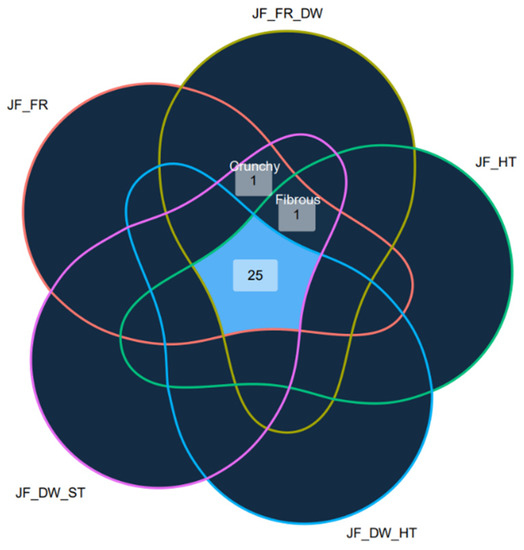
Figure 2.
Venn diagram related to the attributes chosen by 30% of the panel to describe JF. Numbers inside the diagram represent the number of terms selected by the panel. In total, 25 terms were common to all the samples; 1, crunchy, was absent in JF DW and JF HT; and 1, fibrous, was absent only in JF HT.
Mean RATA intensity scores gave a characterization of each JF treatment, indicating the most representative attributes for each product. For all the samples analyzed, there was a slight difference among the mean intensities registered for the selected attributes.
JF-FR (Figure 3) showed a great standard deviation among the attributes selected. The highest mean intensity was registered for visual attributes (color uniformity, brightness, transparency), sea-related descriptors (sea flavor, sea odor and salty) and some tactile attributes (chewy, jelly-like, juicy).
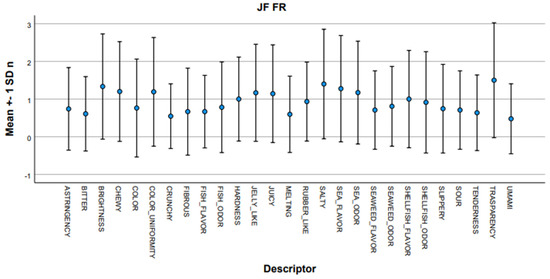
Figure 3.
Error bar of the intensity mean score for descriptors selected for sample JF-FR. Bars represent standard deviation.
JF-FR DW (Figure 4) showed a lower standard deviation for some attributes, indicating the panel agreed on those intensities (astringency, bitter, umami). The visual attributes (brightness, color uniformity and transparency) showed the highest intensities along with some texture attributes (chewy, hardness, jelly-like) and sea-related attributes (sea odor and sea flavor).
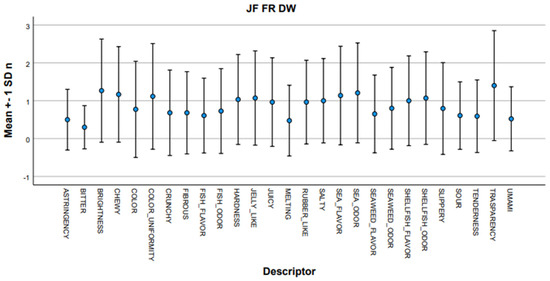
Figure 4.
Error bar of the intensity mean score for descriptors selected for sample JF-FR-DW. Bars represent standard deviation.
JF-HT (Figure 5) showed a standard deviation comparable to the other JF analyzed. The highest mean intensity was mainly scored on texture attributes (chewy, jelly-like, juicy) and sea-related attributes (sea odor, sea flavor and salty).
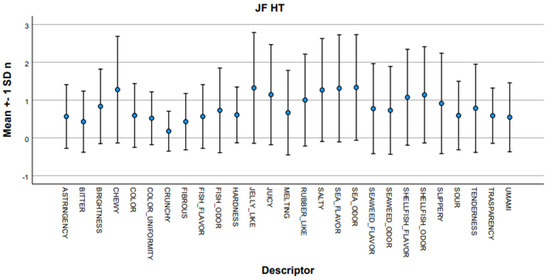
Figure 5.
Error bar of the intensity mean score for descriptors selected for sample JF-HT. Bars represent standard deviation.
JF-DW-HT (Figure 6) showed a standard deviation in line with the other JF. Again, the attributes with the highest values were texture attributes (jelly-like, chewy) along with a visual attribute (brightness) and sea-related descriptors (sea odor, sea flavor, salty, shellfish odor and shellfish flavor).
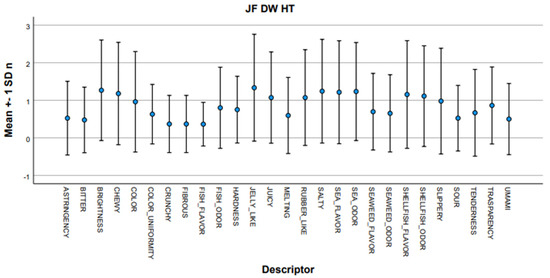
Figure 6.
Error bar of the intensity mean score for descriptors selected for sample JF-DW-HT. Bars represent standard deviation.
JF-DW-ST (Figure 7) showed a great standard deviation, meaning there was little agreement among the panelists on those ratings. The descriptors that scored the highest intensities and described the JF the most were: texture attributes (chewy, jelly-like, hardness, rubber-like), sea-related attributes (sea odor, sea flavor, shellfish flavor, shellfish odor, salty) and visual attributes (brightness, transparency).
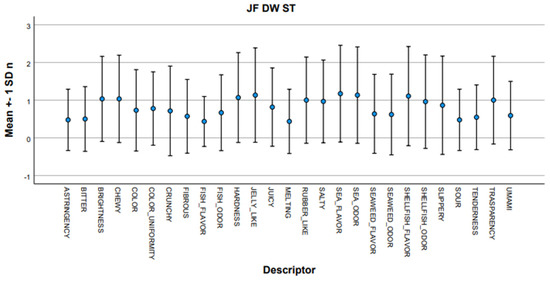
Figure 7.
Error bar of the intensity mean score for descriptors selected for sample JF-DW-ST. Bars represent standard deviation.
3.2. Descriptive Analysis
Descriptive analysis was adopted to validate the selected lexicon. The sensory profiles of the JF processed according to different methodologies are presented in Table 4 and Figure 6. Acceptability was included in the following table and figure, as it was presented contextually to the DA questionnaire, even if it was not actually part of the DA.

Table 4.
ANOVA analysis of DA intensity scores and acceptability by sample. Different letters correspond to significantly different means.
The ANOVA analysis confirmed the lexicon validity for highlighting product differences. Significant differences were registered for most of the attributes, showing a substantial gap between the products processed according to Leone et al. [12] and the product from the eastern market (Table 4). JF-FR-DW and JF-DW-HT showed higher intensities than the Chinese JF for all of the descriptors tested, except for the two texture attributes (Figure 8), hardness and crunchy, which were significantly higher for the eastern JF. JF-FR DW and JF-DW-HT had a similar sensory profile, but significant differences were recorded for the descriptors bitter, astringent and crunchy, all higher for JF-FR DW than for JF-DW-HT. The Chinese product was characterized by a crunchy and hard texture with lower flavor and odor intensities compared to JF-FR-DW and JF-DW-HT.
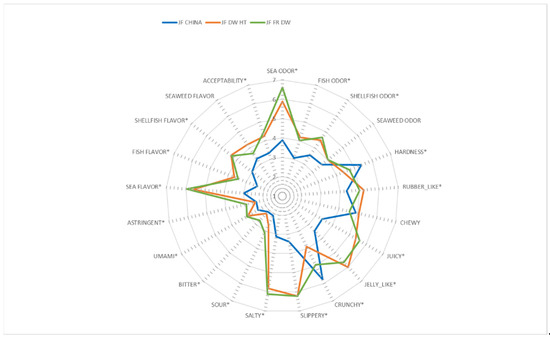
Figure 8.
Spider plot of DA intensity scores by sample on a 9-point scale. Significant differences (p < 0.005) are marked by *.
Product acceptability was low for all the tested samples; however, the most liked sample was JF-FR-DW, followed by JF-DW-HT.
4. Discussion
RATA has been used previously to profile products by consumers and has been depicted as a lower resolution alternative to traditional sensory methods to produce data with relevance to consumer sensory perceptions, with reduced time frames for data acquisition [49]. In this research, it was shown that RATA advantages provided a solution to ease the long and complicated traditional sensory lexicon development stage in the case of novel food, such as edible JF, where panelists can be considered low-trained assessors, just like regular consumers. The RATA method provided a panelist-friendly tool, which was effective in defining a striking and comprehensive lexicon for JF characterization, also evidenced by the high discriminating power highlighted in the DA test used to validate the descriptors selected [50].
As assessed by Lawless et al. [26], the panel leader’s experience was essential in selecting the best terms to describe the products, removing vague, redundant and repetitive terms. However, due to the presence of 34 terms, RATA provided great support to the panel leader’s role. Indeed, CATA and RATA are particularly recommended in the presence of a large number of terms to provide a complete description of the samples’ sensory characteristics [51].
RATA allowed a further simplification of the lexicon development principles, skipping the finalization step after term selection and going through the direct attribute application and rating [28]. Indeed, according to the lexicon development principles, once the terms are selected, there must be a time-consuming step, finalization, and the panel can be presented with samples to revise the descriptors [26].
RATA application yielded results in line with the literature; the visual and texture attributes, as well as sea odor and flavor, were highly involved in JF description, in agreement with Youssef et al. [5] who highlighted the texture and visual features’ impact of edible JF. However, the high standard deviation obtained in the RATA data gave an overview of the low panel consensus on the attributes’ intensity scales use, showing the panel still need some training on JF sensory analysis due to the novelty of this food.
The results obtained from the descriptive analysis revealed the validity of the lexicon developed in highlighting the variability among and within JF samples. As observed in the RATA analysis, differences were mainly related to the texture and odor/flavor resembling the sea.
This research represents a propaedeutic study on JF sensory properties, as shown by the low acceptability results, indicating the panel was not familiar with this novel food. Indeed, familiarity and food expectations have an impact on food acceptability [52]. A future possible diffusion of JF food would probably improve acceptability.
Previous studies [47,53] have already dealt with JF sensory analysis, considering only a reduced number of descriptors. The extensive lexicon presented in our research offers the opportunity to detail the JF sensory characterization, capturing additional similarities and differences among the samples.
The main novelty of this research was the application of a rapid method, such as the RATA, to simplify the complex and critical phase of lexicon development necessary for communicating within the panel but also with producers, marketing professionals and suppliers [26]. Moreover, this method is easily applicable to novel foods, such as edible JF, for which little sensory information is yet available in Western countries, making panel training complicated. Thus, RATA could be an alternative tool to obtain insight into novel food perceptions by untrained or low-trained assessors, helping to create a standardized vocabulary, which forms the basis of sensory analysis.
5. Conclusions
The lexicon is a fundamental tool in sensory analysis of novel foods, which still need to be explored in terms of perceptions. The development of new processes and products from edible JF species requires not only clear safety parameters [2] but also suitable quality parameters, including adequate sensory descriptors.
This research showed that RATA could be a reliable alternative to the traditional lexicon development method, not only in selecting sensory descriptors but also in highlighting their importance, giving an insight into JF sensory variability.
Since JF were completely new to the panel employed, a possible limitation of this study arose from the number of assessors available for the RATA test, perhaps influenced by unfamiliarity with the product. The lexicon developed was able to describe the sensory differences existing between the JF samples, providing a good communication instrument that will open up future studies on JF sensory characteristics, improving JF palatability and encouraging JF introduction to Western cuisines.
Author Contributions
Conceptualization, A.L. and S.P.; methodology, A.L., S.D.D. and S.P.; investigation, A.L., C.M., M.C. and G.M.D.; data curation, S.P., C.M., M.C. and G.M.D.; resources, A.L.; writing—original draft preparation, A.L. and C.M.; writing—review and editing, S.D.D., A.L. and C.M.; supervision, S.P.; funding acquisition, A.L. All authors have read and agreed to the published version of the manuscript.
Funding
H2020 European Commision; Regione Puglia; Italy. This work has received funding from the EU project “GoJelly–A gelatinous solution to plastic pollution”, under the European Union’s Horizon 2020 research and innovation program, grant agreement No. 774499. Stefania De Domenico was also supported in her research by the Apulian Region program “REFIN-Research for Innovation” (practice code AFD9B120, project idea UNISAL119).
Institutional Review Board Statement
The sensory experiment was conducted in agreement with the Declaration of Helsinki. No ethics approval was required, as an expert panel carried out the evaluation. In terms of compliance with ethical standards, the jellyfish Rhizostoma pulmo is an invertebrate (Cnidaria), which is not an endangered or protected species, and therefore, no permission was needed for the sampling, which was realized during jellyfish blooms. In the absence of specific guidelines relating to the slaughter of Cnidarians [4,54,55], a method based on the latest new taxa-specific knowledge of their physiology and anatomy, which minimizes the potential distress or pain in all animal taxa, was employed.
Informed Consent Statement
Informed consent was obtained from all subjects involved in the study.
Conflicts of Interest
The authors declare no conflict of interest.
References
- Boero, F. Review of Jellyfish Blooms in the Mediterranean and Black Sea. Studies and Reviews. Available online: http://www.fao.org/docrep/017/i3169e/i3169e.pdf (accessed on 20 June 2019).
- Bleve, G.; Ramires, F.A.; Gallo, A.; Leone, A. Identification of Safety and Quality Parameters for Preparation of Jellyfish Based Novel Food Products. Foods 2019, 8, 263. [Google Scholar] [CrossRef] [PubMed]
- Hsieh, Y.H.P.; Rudloe, J. Potential of utilizing jellyfish as food in western countries. Trends Food Sci. Technol. 1994, 5, 225–229. [Google Scholar] [CrossRef]
- Hsieh, Y.H.P.; Leong, F.M.; Rudloe, J. Jellyfish as food. Hydrobiologia 2001, 451, 11–17. [Google Scholar] [CrossRef]
- Youssef, J.; Keller, S.; Spence, C. Making sustainable foods (such as jellyfish) delicious. Int. J. Gastron. Food Sci. 2019, 16, 5. [Google Scholar] [CrossRef]
- Huang, Y.W. Cannonball jellyfish (stomolophus-meleagris) as a food resource. J. Food Sci. 1988, 53, 341–343. [Google Scholar] [CrossRef]
- Yin, Q.; Zhang, D.; Liu, Y.; Jiang, N. Study on processing technology of jellyfish. China Fish 2000, 27, 46. [Google Scholar]
- Brotz, L.; Schiariti, A.; Lopez-Martinez, J.; Alvarez-Tello, J.; Hsieh, Y.H.P.; Jones, R.P.; Quinones, J.; Dong, Z.J.; Morandini, A.C.; Preciado, M.; et al. Jellyfish fisheries in the Americas: Origin, state of the art, and perspectives on new fishing grounds. Rev. Fish Biol. Fish. 2017, 27, 1–29. [Google Scholar] [CrossRef]
- Aguilar, F.; Autrup, H.; Barlow, S.; Castle, L.; Crebelli, R.; Dekant, W.; Engel, K.H.; Gontard, N.; Gott, D.; Grilli, S.; et al. Safety of aluminium from dietary intake. EFSA J. 2008, 6, 34. [Google Scholar] [CrossRef]
- Nayak, P. Aluminum: Impacts and disease. Environ. Res. 2002, 89, 101–115. [Google Scholar] [CrossRef]
- Leone, A.; Bleve, G.; Gallo, A.; Ramires, F.A.; De Domenico, S.; Perbellini, E. Method for the treatment of jellyfish intendedfor human consumption without the use of aluminium salts andproducts/ingredients obtained by this process. Eur. Pat. 2021, 3, 224. [Google Scholar]
- Leone, A.; Lecci, R.; Milisenda, G.; Piraino, S. Mediterranean jellyfish as novel food: Effects of thermal processing on antioxidant, phenolic, and protein contents. Eur. Food Res. Technol. 2019, 245, 1611–1627. [Google Scholar] [CrossRef]
- Ramires, F.; De Domenico, S.; Migoni, D.; Fanizzi, F.; Angel, D.; Slizyte, R.; Klun, K.; Bleve, G.; Leone, A. Optimization of a Calcium-Based Treatment Method for Jellyfish to Design Food for the Future. Foods 2022, 11, 2697. [Google Scholar] [CrossRef] [PubMed]
- Bleve, G.; Ramires, F.A.; De Domenico, S.; Leone, A. An Alum-Free Jellyfish Treatment for Food Applications. Front. Nutr. 2021, 8, 21. [Google Scholar] [CrossRef] [PubMed]
- De Domenico, S.; De Rinaldis, G.; Paulmery, M.; Piraino, S.; Leone, A. Barrel Jellyfish (Rhizostoma pulmo) as Source of Antioxidant Peptides. Mar. Drugs 2019, 17, 134. [Google Scholar] [CrossRef]
- Brotz, L.; Pauly, D. Jellyfish populations in the Mediterranean Sea. Acta Adriat. 2012, 53, 213–231. [Google Scholar]
- Condon, R.H.; Duarte, C.M.; Pitt, K.A.; Robinson, K.L.; Lucas, C.H.; Sutherland, K.R.; Mianzan, H.W.; Bogeberg, M.; Purcell, J.E.; Decker, M.B.; et al. Recurrent jellyfish blooms are a consequence of global oscillations. Proc. Natl. Acad. Sci. USA 2013, 110, 1000–1005. [Google Scholar] [CrossRef]
- Canepa, A.; Fuentes, V.; Sabatés, A.; Piraino, S.; Boero, F.; Gili, J. Pelagia noctiluca in the Mediterranean Sea. In Jellyfish Blooms; Pitt, K., Lucas, C., Eds.; Springer: Dordrecht, The Netherlands, 2014. [Google Scholar]
- Kingsford, M.J.; Pitt, K.A.; Gillanders, B.M. Management of jellyfish fisheries, with special reference to the Order Rhizostomeae. In Oceanography and Marine Biology; Gibson, R.N., Barnes, M., Eds.; Taylor & Francis Ltd.: London, UK, 2000; Volume 38, pp. 85–156. [Google Scholar]
- Torri, L.; Tuccillo, F.; Bonelli, S.; Piraino, S.; Leone, A. The attitudes of Italian consumers towards jellyfish as novel food. Food Qual. Prefer. 2020, 79, 10. [Google Scholar] [CrossRef]
- Tan, H.S.G.; Tibboel, C.J.; Stieger, M. Why do unusual novel foods like insects lack sensory appeal? Investigating the underlying sensory perceptions. Food Qual. Prefer. 2017, 60, 48–58. [Google Scholar] [CrossRef]
- Grunert, K.G.; van Trijp, H.C.M. Consumer-Oriented New Product Development. In Encyclopedia of Agriculture and Food Systems; Van Alfen, N.K., Ed.; Academic Press: Cambridge, MA, USA, 2014; pp. 375–386. [Google Scholar]
- Das, A.K.; Nanda, P.K.; Madane, P.; Biswas, S.; Das, A.; Zhang, W.G.; Lorenzo, J.M. A comprehensive review on antioxidant dietary fibre enriched meat-based functional foods. Trends Food Sci. Technol. 2020, 99, 323–336. [Google Scholar] [CrossRef]
- Suwonsichon, S. The Importance of Sensory Lexicons for Research and Development of Food Products. Foods 2019, 8, 27. [Google Scholar] [CrossRef]
- Chun, S.; Chambers, E.; Han, I. Development of a Sensory Flavor Lexicon for Mushrooms and Subsequent Characterization of Fresh and Dried Mushrooms. Foods 2020, 9, 980. [Google Scholar] [CrossRef] [PubMed]
- Lawless, L.J.R.; Civille, G.V. Developing Lexicons: A Review. J. Sens. Stud. 2013, 28, 270–281. [Google Scholar] [CrossRef]
- Hofmanova, J.K.; Mason, J.; Batchelor, H.K. Sensory attributes of coated tablets: Developing a formal lexicon and sensory wheel. Int. J. Pharm. 2020, 590, 7. [Google Scholar] [CrossRef] [PubMed]
- Ares, G.; Bruzzone, F.; Vidal, L.; Cadena, R.S.; Gimenez, A.; Pineau, B.; Hunter, D.C.; Paisley, A.G.; Jaeger, S.R. Evaluation of a rating-based variant of check-all-that-apply questions: Rate-all-that-apply (RATA). Food Qual. Prefer. 2014, 36, 87–95. [Google Scholar] [CrossRef]
- Ares, G.; Deliza, R.; Barreiro, C.; Gimenez, A.; Gambaro, A. Comparison of two sensory profiling techniques based on consumer perception. Food Qual. Prefer. 2010, 21, 417–426. [Google Scholar] [CrossRef]
- Drake, M.A.; Civille, G.V. Flavor Lexicons. Compr. Rev. Food Sci. Food Saf. 2003, 2, 33–40. [Google Scholar] [CrossRef]
- Predieri, S.; Sinesio, F.; Monteleone, E.; Spinelli, S.; Cianciabella, M.; Daniele, G.M.; Dinnella, C.; Gasperi, F.; Endrizzi, I.; Torri, L.; et al. Gender, Age, Geographical Area, Food Neophobia and Their Relationships with the Adherence to the Mediterranean Diet: New Insights from a Large Population Cross-Sectional Study. Nutrients 2020, 12, 1778. [Google Scholar] [CrossRef]
- Sun, C.; Koppel, K.; Chambers, E. An Initial lexicon of sensory properties for nail polish. Int. J. Cosmet. Sci. 2014, 36, 262–272. [Google Scholar] [CrossRef]
- Tran, T.; James, M.N.; Chambers, D.; Koppel, K.; Chambers, E. Lexicon development for the sensory description of rye bread. J. Sens. Stud. 2019, 34, 10. [Google Scholar] [CrossRef]
- Societa Italiana di Scienze Sensoriali. Atlante Sensoriale dei Prodotti Alimentari; Sinesio, F.M.E., Spinelli, S., Eds.; Tecniche Nuove: Milan, Italy, 2012. [Google Scholar]
- Lee, I.S.; Yang, H.M.; Kim, J.W.; Maeng, Y.J.; Lee, C.W.; Kang, Y.S.; Rang, M.J.; Kim, H.Y. Terminology development and panel training for sensory evaluation of skin care products including aqua cream. J. Sens. Stud. 2005, 20, 421–433. [Google Scholar] [CrossRef]
- Grahl, S.; Palanisamy, M.; Strack, M.; Meier-Dinkel, L.; Toepfl, S.; Morlein, D. Towards more sustainable meat alternatives: How technical parameters affect the sensory properties of extrusion products derived from soy and algae. J. Clean. Prod. 2018, 198, 962–971. [Google Scholar] [CrossRef]
- Dever, M.C.; MacDonald, R.A.; Cliff, M.A. Sensory evaluation of sweet cherry cultivars. Hortscience 1996, 31, 150–153. [Google Scholar] [CrossRef]
- Lanza, C.M.; Mazzaglia, A.; Pagliarini, E. Sensory Profile of a Specialty Sicilian Chocolate. Ital. J. Food Sci. 2011, 23, 36–44. [Google Scholar]
- Cherdchu, P.; Chambers, E.; Suwonsichon, T. Sensory Lexicon Development Using Trained Panelists in Thailand and the USA: Soy Sauce. J. Sens. Stud. 2013, 28, 248–255. [Google Scholar] [CrossRef]
- Donadini, G.; Fumi, M.; Porretta, S. Hedonic Response to Fish in Preschoolers. J. Sens. Stud. 2013, 28, 282–296. [Google Scholar] [CrossRef]
- Liguori, G.; Sortino, G.; Gianguzzi, G.; Inglese, P.; Farina, V. Evaluation of quality attributes and consumer preference of fresh or imported mangoes in Italy. AIMS Agric. Food 2018, 3, 426–440. [Google Scholar] [CrossRef]
- Kumar, R.; Chambers, E. Understanding the Terminology for Snack Foods and Their Texture by Consumers in Four Languages: A Qualitative Study. Foods 2019, 8, 484. [Google Scholar] [CrossRef]
- Rodbotten, M.; Kubberod, E.; Lea, P.; Ueland, O. A sensory map of the meat universe. Sensory profile of meat from 15 species. Meat Sci. 2004, 68, 137–144. [Google Scholar] [CrossRef]
- FAO Codex Committee on Fish and Fishery Products (CCFFP). Guidelines for the Sensory Evaluation of Fish and Shellfish in Laboratories; CXG 31-1999; FAO: Rome, Italy, 1999. [Google Scholar]
- Bengtsson, H.; Hall, C.; Tornberg, E. Effect of physicochemical properties on the sensory perception of the texture of homogenized fruit and vegetable fiber suspensions. J. Text. Stud. 2011, 42, 291–299. [Google Scholar] [CrossRef]
- Onyeoziri, I.; Torres-Aguilar, P.; Hamaker, B.; Taylor, J.; de Kock, H. Descriptive sensory analysis of instant porridge from stored wholegrain and decorticated pearl millet flour cooked, stabilized and improved by using a low-cost extruder. J. Food Sci. 2021, 86, 3824–3838. [Google Scholar] [CrossRef]
- Raposo, A.; Coimbra, A.; Amaral, L.; Goncalves, A.; Morais, Z. Eating jellyfish: Safety, chemical and sensory properties. J. Sci. Food Agric. 2018, 98, 3973–3981. [Google Scholar] [CrossRef] [PubMed]
- Galetti, J.A.; Calder, B.L.; Skonberg, D.I. Mechanical Separation of Green Crab (Carcinus maenas) Meat and Consumer Acceptability of a Value-Added Food Product. J. Aquat. Food Prod. Technol. 2017, 26, 172–180. [Google Scholar] [CrossRef]
- Niimi, J.; Collier, E.; Oberrauter, L.; Sorensen, V.; Norman, C.; Normann, A.; Bendtsen, M.; Bergman, P. Sample discrimination through profiling with rate all that apply (RATA) using consumers is similar between home use test (HUT) and central location test (CLT). Food Qual. Prefer. 2022, 95, 104377. [Google Scholar] [CrossRef]
- Civille, G.V.; Lapsley, K.; Huang, G.; Yada, S.; Seltsam, J. Development of an almond lexicon to assess the sensory properties of almond varieties. J. Sens. Stud. 2010, 25, 146–162. [Google Scholar] [CrossRef]
- Jaeger, S.; Beresford, M.; Paisley, A.; Antunez, L.; Vidal, L.; Cadena, R.; Gimenez, A.; Ares, G. Check-all-that-apply (CATA) questions for sensory product characterization by consumers: Investigations into the number of terms used in CATA questions. Food Qual. Prefer. 2015, 42, 154–164. [Google Scholar] [CrossRef]
- Olabi, A.; Neuhaus, T.; Bustos, R.; Cook-Camacho, M.; Corvi, T.; Abdouni, L. An investigation of flavor complexity and food neophobia. Food Qual. Prefer. 2015, 42, 123–129. [Google Scholar] [CrossRef]
- Xu, C.A. Determination of Aluminum Content in Food Products and Texture Profile of Jellyfish Products University of Georgia. Ph.D. Thesis, University of Georgia, Athens, Georgia, 2013. [Google Scholar]
- American Veterinary Medical Association. AVMA Guidelines for the Humane Slaughter of Animals: 2016 Edition. Available online: https://www.avma.org/sites/default/files/resources/Humane-Slaughter-Guidelines.pdf (accessed on 20 September 2019).
- Murray, M.J. Euthanasia. In Invertebrate Medicine, 3rd ed.; Lewbart, G., Ed.; Wiley-Blackwell: Hoboken, NJ, USA, 2022. [Google Scholar]
Publisher’s Note: MDPI stays neutral with regard to jurisdictional claims in published maps and institutional affiliations. |
© 2022 by the authors. Licensee MDPI, Basel, Switzerland. This article is an open access article distributed under the terms and conditions of the Creative Commons Attribution (CC BY) license (https://creativecommons.org/licenses/by/4.0/).